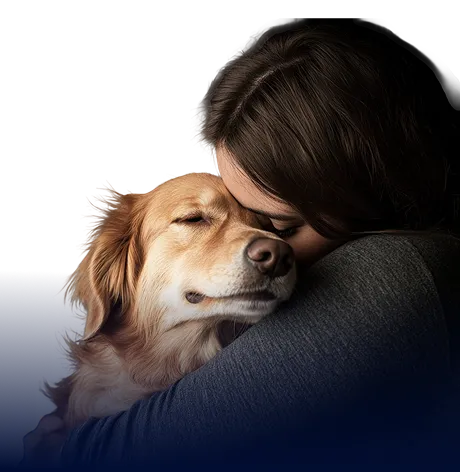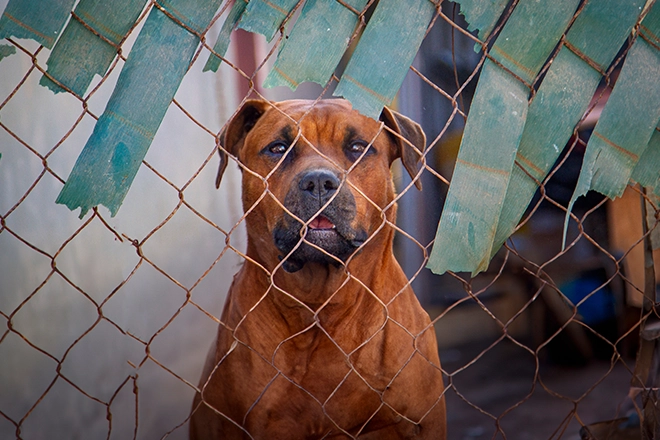For the Purrbabies


Territorial behavior can be frustrating, but it’s manageable with the right mix of structure, stimulation, and support.

It can be incredibly frustrating if your dog is territorial or aggressive. Walks, trips to the dog park, and other everyday tasks can feel momentous as you navigate how your dog reacts to people, other dogs, or objects. But there are ways to manage your dog’s reactions to external stimuli. Keep reading as we explore some of the best tips to help with your territorial dog.
Your dog’s idea of “territory” can be several things. Have you ever noticed how your dog’s ears perk up when you drive back into your neighborhood? Or how they sniff extra hard when you’re driving past your local coffee shop? It’s because dogs know their territory. Dogs have several zones that they see as being “theirs.” But that doesn’t mean they get inherently territorial over all of those places.
Your home is the most common place to invoke a territorial behavior in your dog, and that can include the front and back yards as well as the street. Dogs may bark, growl, or lunge to guard these areas, especially when unfamiliar people or pets approach.
Dogs are wired to protect—it’s instinctive. But some breeds are more likely to guard than others. Not only is breed a factor, but excessive guarding behavior can be triggered by fear, lack of socialization, or past trauma. Meaning it can happen to any dog in any situation. In some cases, dogs resort to aggression because they feel it's the only way to control their environment. Over time, this behavior can become more frequent or intense if not addressed.
There are ways to prevent territorial aggression from ever starting. While it's often best to start this training when your dog is a puppy, training your dog not to exhibit these behaviors is doable at any age. More often than not, socialization and basic training courses can be enough to get your dog comfortable around other animals, people, and places.
We have several guides on why animals may develop territorial behaviors and the different ways you can set your dog up for success from the start:
Training your dog to respond to basic cues like “sit,” “stay,” and “leave it” helps redirect their energy and reinforces calm behavior. Also, training your dog how to “settle” and “go to your place” can help replace territorial behaviors. Training isn’t just about control; it helps build trust and shows your dog there’s a better way to respond. Keep sessions short and positive, and use a calm voice when issuing commands.
If you don’t feel comfortable training your dog yourself, there are professionals you can consult. Or, ask your vet for their recommendation.
Bored dogs are more likely to obsess over guarding their territory. Enrichment—puzzle feeders, nose work games, new walking routes—can help shift your dog’s focus from perceived threats to healthy, confidence-building activities. And to keep things new and refreshing, make small shifts in your daily routine, like changing your walking route.
Physical activity reduces tension and can lower reactivity. A tired dog is often a less territorial one. If your pup guards the house, prioritize long walks or outdoor play sessions before visitors arrive. Get creative, too. If you don’t have access to a running/walking trail or a dog park, there are still a ton of ways to get active, like agility courses (you can even make your own at home).
You don’t have to give your dog full access to every window, fence line, or hallway in your home or on your property. Using barriers or curtains can reduce visual triggers, especially in high-traffic areas. No more barking at the daily mailman drop off. You can also crate train or teach a “place” command to help your dog settle away from stressors. Or, you can put your dog in a different room when you have visitors.
If you’re worried about biting, consider using basket muzzle training. We caution that you should do this correctly, as some dogs can develop a fear or aversion to muzzles if not trained properly. These are perfect for dogs who have shown aggressive behavior in the past, since it's an extra level of safety when training or introducing your dog to new people or animals.
When your dog stays calm in situations where they’d normally react, let them know! Praise, gentle petting, and attention can reinforce what you want to see more of. Sometimes, treats say it best. Reinforce non-reactive moments with small, high-reward snacks. You can even pre-load a treat pouch so you’re ready the moment your dog makes a good choice. And on that note, refrain from punishing your dog for exhibiting territorial behaviors. It actually can make your dog have more negative feelings and can potentially set your training back.
Desensitization and counterconditioning are behavior modification techniques used to help dogs overcome fear, anxiety, or aggression triggered by specific stimuli. Desensitization involves gradually and systematically exposing your dog to a stimulus (sounds of thunder, vacuum cleaners, etc.) at low intensity to build up tolerance. Counterconditioning, on the other hand, replaces a negative emotional reaction with a positive one through consistent pairing (e.g., treats or praise).
🐾Explore our complete guide for desensitization and counterconditioning to understand when to use the techniques and how to ensure success.
"Positive reinforcement training is not only the most effective training method, but it also strengthens the bond between you and your dog without causing fear and anxiety like some punishment-based techniques. Professional help and a multimodal approach is key for managing aggressive dogs, often including safety and environmental management, behavioral modification, and medications." - Liza Cahn, DVM
There’s no shame in asking for help, especially if you have a dog breed that’s misunderstood or restricted in certain communities. A professional, board-certified veterinary behaviorist can help identify your dog’s specific triggers and tailor a behavioral modification plan, medication, and changes to the environment that work for your home and lifestyle. But don’t wait until things escalate. Early intervention is the best route here.
Having a dog that requires a little extra time and patience can be a struggle. After all, we want to be able to take our furry friends everywhere, and being territorial or aggressive can make that not only difficult but also unsafe. Take comfort in knowing that this is a natural behavior that can be adjusted to be less of a roadblock with a few adjustments.
👉If aggressive behavior comes on suddenly or is new, see your vet to rule out any medical issues.
Start with obedience training and a management plan that involves desensitization and counterconditioning, but be sure to also limit triggers and increase exercise and enrichment. For more severe behavior, or if you aren’t comfortable doing so yourself, work with a professional trainer.
Guarding breeds like German Shepherds, Rottweilers, and Chow Chows are more prone to territorial behavior, but any dog can be territorial depending on environment and upbringing.
Both males and females can display territorial tendencies. Intact males (those that haven’t been neutered) may be slightly more prone, but behavior depends more on the individual dog than on a given breed or gender.
There are multiple factors that can contribute, including natural instinct, fear, past experiences, or lack of training. Dogs may feel they need to protect their space or people from unfamiliar intrusions.








